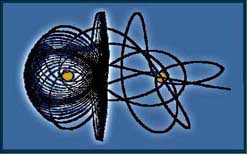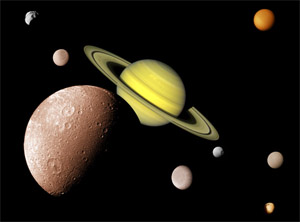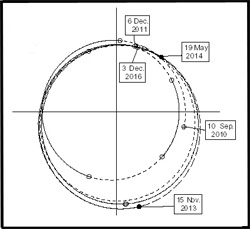ettore
perozzi CV
 CELESTIAL
MECHANICS
CELESTIAL
MECHANICS
In
the last decades, the widespread diffusion of digital computers, the sharp
increase in their performances and the significant advances in chaos theory, has allowed a deeper
understanding of several fundamental problems of celestial mechanics.
It is now possible to follow the orbital motion of celestial bodies
for a timespan comparable with the age of our planetary system: five
billion years. On this timescale the Solar System is alive with events
involving the major planets as
well as the small bodies
traveling the interplanetary space. At the same time flight
dynamics specialists have learned how to use complex orbital
patterns for space missions
and are able to determine the position of an artificial satellite with
an
unprecedented accuracy. Thus modern
celstial mechanics reveals a truly interdisciplinary character,
involving the scientific as well as the industrial community.
Within this framework, the CELMEC meetings have been organised
with the aim of estabilishing a common
ground and find connections among the various fields of study
involving celestial mechanics. Born at a national level in May 1993, and regularily repeated at
a 4-year interval, the CELMEC
meetings have quickly become a focal point to matematicians,
astronomers and engineers working in celestial mechanics all over the
world. About 100 participants
attended CELMEC III,
which
took place in Villa Mondragone (Rome, Italy) in June 2001: the proceedings have been published as a
special issue of the international journal Celestial Mechanics and Dynamical
Astronomy (vol. 83, 2002).
Following the success of this approach, the Italian Celestial Mechanics and Astrodinamics
Society (SIMCA - Societa' Italiana di
Meccanica Celeste e Astrodinamica) has been also established in
January 2002.
 N-BODY
PROBLEM
N-BODY
PROBLEM
Due
to the intrinsic non-integrability
of the N-Body problem, the use of step-by-step
numerical integration techniques has grown together with the availability of fast and reliable
computers.The
Laurea Thesis deals with the
extension of Discrete Mechanics
(an energy and angular momentum conserving numerical method for the
integration of ordinary differential equations) to the case of an
object orbiting around an oblate
spheroid. Limitations intrinsic to the method are found, leading
to a more general study on the efficiency of the most common numerical
integrators used in celestial mechanichs to solve the N-body problem. A
special attention is paid to the treatment of strong gravitational interactions,
such as the occurrence of close encounters of comets with the major
planets, and to the
propagation of truncation and round-off errors during the integration. This leads to the choice of RADAU
(by E. Everhart) as
the core integrator for the development of high efficieny, high accuracy software
to study the orbital evolution of Minor
Bodies, to look for periodic orbits in the Main Lunar
Problem, as well as for near-Earth and interplanetary mission design.
A specific three and
four-body perturbation model (including the J2, J4 and J6 potential
terms) is also developed in order both, to study the long term
stability of the two coorbital satellites
of Saturn (Ephimeteus and
Janus) and to test
numerically the so-called co-rotational
resonance theory which
provides the basic dynamical description of the motion of the ring arcs
of Neptune. The same model is used to investigate the stability
of a peculiar extra-solar planetary
system composed by two equal masses in a 1:1 resonance around a
pulsar.
 MISSION
ANALYSIS
MISSION
ANALYSIS
A numerical approach is
applied to
the ESA SOHO (Solar Heliospheric Observatory) transfer
trajectory and to the CASSINI
/ Huygens
probe Titan encounter trajectory. In both cases the extreme sensitivity
of the orbital path to inaccuracies in the dynamical model adopted and
the importance of distant perturbations are pointed out.
A general
purpose software (OPA: Orbit
Perturbation Analysis) performing the orbital evolution of artificial satellites, with special
emphasis on those in high eccentricity and inclination orbits, is
developed under Italspazio
contract.
The classical Hohmann and Opik analythical methods are used
to
develop targeting
strategies for mission analysis, such as
the H-plot accessibility criterion
of near-Earth asteroids
(NEAs) and the dynamics of close flybys.
 references
references
Atti
del Primo Convegno Nazionale di Meccanica Celeste. A.
Celletti & E. Perozzi
(editors) 118 pp,
L'Aquila, Dicembre 1993.
Second
Italian Meeting on Celestial Mechanics. A.
Celletti, A. Milani, E. Perozzi
(editors) Planetary
and Space Science,
Special Issue, vol.46 n.11/12, 215 pp, Nov/Dec 1998.
CELMEC III -Third
Meeting
on Celestial Mechanics. A.Celletti, S.
Ferraz-Mello, J. Henrard (editors), Celestial Mechanics and
Dynamical Astronomy. Special Issue, vol. 83, 2002.
Meccanica
Celeste: A. Celletti & E. Perozzi, CUEN,
Napoli, collana Tessere n.24, 140 pp, 1996. more
Costruzione di un Algoritmo per
l'Integrazione delle Equazioni del Moto della Meccanica Discreta nel
Campo Gravitazionale di uno Sferoide Oblato. E.
Perozzi, Laurea Thesis, Universita' di Roma
"La Sapienza", Aprile 1981.
The Precession of the Argument of
Pericentre in Discrete Mechanics. E.
Perozzi. IAS-Internal Report n.25, 13 pag.s,
1981.
Discrete
Mechanics: Some Remarks. E.
Perozzi, Celestial Mechanics n.30, 249-261,
1983.
Perturbation Computations and Numerical
Modelling Experiments. A.
Carusi, E. Perozzi, G.B. Valsecchi. In
proc. 'International School of Physics Enrico Fermi', Rendiconti
S.I.F.- XCVIII, 191-201, 1985.
On Testing N-Body
Numerical Integration Techniques: Some
General Remarks and an Application to the SOHO Transfer Trajectory.
E. Perozzi. ESA-ESOC
Mission
Analysis Office WP 210, 24 pp, 1984.
One of the Problems of Long-Term
Integrations of Cometary Orbits.
A. Carusi, E. Perozzi, E. Pittich, G.B.
Valsecchi. In
proc. 'Dynamics of
Comets', IAU Coll.83, A.Carusi & G.B.Valsecchi eds, 227-235,
1985.
Influence of Close Encounters on the
Determination of Cometary Orbits.
A. Carusi, E. Perozzi, E. Pittich, G.B. Valsecchi In
proc. 'The Few Body Problem',
M.Valtonen ed, 195-199, 1988.
First Ground-based
images of Neptune's Ring Arcs.
B. Sicardy, F. Roddier, C. Roddier,
E. Perozzi, J.E. Graves, O. Guyon,
M.J. Northcott: Nature 400, 731-733, 1999
The Glitches of the Anomalous X-ray Pulsar
1RXS J170849.0-400910.
S. Dall'Osso, G.L. Israel, L. Stella,
A. Possenti, E. Perozzi. arXiv:
astro-ph/0307235v2, (submitted) 2003.
Dynamics of the CASSINI
Titan Close Encounter.
E. Perozzi. In
proc. 'The Solid Bodies of the Outer Solar System', ESA SP-242,
A.Coradini & M.Fulchignoni eds, 283-289, 1986.
Exploiting
Earth Horseshoe Orbits for Space Missions.
G.B. Valsecchi and E. Perozzi. Planetary
and Space Science, vol.46
n.11/12, 1623-1626, 1998.
Basic Targeting Strategies for Rendezvous
and Flyby Missions to the Near-Earth Asteroids.
E. Perozzi, A. Rossi, G.B. Valsecchi. Planetary
and Space Science 49,
3-22, 2001.
COMETS
ASTEROIDS
LUNAR
SAROS
CELESTIAL
MECHANICS
INTERPLANETARY
MISSIONS
 CELESTIAL
MECHANICS
CELESTIAL
MECHANICS CELESTIAL
MECHANICS
CELESTIAL
MECHANICS N-BODY
PROBLEM
N-BODY
PROBLEM MISSION
ANALYSIS
MISSION
ANALYSIS references
references